Papers by Frederic Vallee-Tourangeau
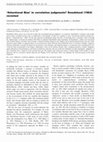
Scandinavian Journal of Psychology, Dec 1, 1998
Smedslund (1963) reports one of the first studies that investigated human judgments of correlatio... more Smedslund (1963) reports one of the first studies that investigated human judgments of correlation. Smedslund's conclusion, that people reason about correlation mostly from a consideration of the number of times two variables co-occur, has become textbook wisdom (e.g. Baron's ''attentional bias'', 1994). Yet the data reported in Smedslund's paper fall short of endorsing such a conclusion. After reviewing the original paper, we present the method with which we replicated Smedslund's main experiment. In Experiment 1 subjects were presented with symptom-disease correlation data through a simulated medical diagnosis task. Subjects clearly discriminated between data sets which shared an equal number of symptom-disease co-occurrences but which otherwise showed different levels of correlation. Subjects' diagnoses showed a propensity to predict the disease in the presence of the symptom, and symptom-disease co-occurrences were overestimated in two of the five data sets presented to the subjects. Experiment 2 used a novel abstract scenario with a symmetric predictor variable. Judgments again indicated good discrimination, and biases in prediction responses and case recall were eliminated. In both experiments, judgments of zero correlation were a function of the outcome base rate. We evaluate and contrast the extent to which Cheng's (1997) model of causal induction and two associative models, Rescorla and Wagner (1972) and Pearce (1987) can anticipate the observed pattern in the mean judgments.

British Journal of Social Psychology, Dec 5, 2022
Empathic accuracy, the ability to accurately infer the mental states of others, is essential to s... more Empathic accuracy, the ability to accurately infer the mental states of others, is essential to successful interpersonal relationships. Perceivers can interpret targets' emotional experiences by decoding facial and voice cues (mentalizing) or by using their own feelings as referents (experience‐sharing). We examined the relative efficacy of these processes via a replication and extension of Zhou et al. (Psychol Sci., 28, 2017, 482) who found experience‐sharing to be more successful but undervalued. Participants estimated targets' emotional ratings in response to positive, neutral and negative images in mentalizing or experience‐sharing conditions. Our analysis of absolute magnitudes of error showed similar levels of accuracy across process conditions (a non‐replication of Zhou et al.); however, our exploratory analysis of directional variation across valence using raw scores revealed a pattern of conservative estimates for affective stimuli, which was accentuated in the mentalizing condition. Thus, our exploratory analysis lends conceptual support to Zhou et al.'s finding that experience‐sharing represents the more successful process, and we replicated their finding that it was nevertheless undervalued. Extending Zhou et al., we also found that empathic accuracy was predicted by individual differences in fiction‐exposure. Future research may further examine the impact of individual differences and stimulus properties in the employment of empathic inferencing strategies.
Thinking Skills and Creativity

There is a type of riddle that Bar-Hillel, Noah and Frederick (2018) call “stumpers”. A stumper i... more There is a type of riddle that Bar-Hillel, Noah and Frederick (2018) call “stumpers”. A stumper is a riddle which is initially intractable because the mental model or representation of the situation described in the riddle does not contain the vital information which is required to solve it. The Cognitive Reflection Task (CRT; Frederick, 2005) on the other hand relies on seemingly completely different cognitive processes. However, exploratory work from Bar-Hillel et al. (2019) suggests that success on stumpers correlates with performance on the CRT. This finding may shed light on the cognitive processes underlying both the resolution of stumpers and the CRT. We replicated the work from Bar-Hillel et al. (2019) suggesting a relationship between performance on the CRT and performance on stumpers as well as extending this to show a relationship between performance on the CRT-v. This may point to the underexplored importance of suppression in solving stumpers and traditional riddles.
Thinking & Reasoning, 2021
We thank Andrea Marin for her time watching the video corpus alongside us and Paul March, Linden ... more We thank Andrea Marin for her time watching the video corpus alongside us and Paul March, Linden Ball and three anonymous reviewers for helpful comments on a previous version of this manuscript.
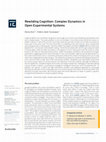
Journal of Trial and Error, 2021
Insight problems are sometimes designed to encourage an incorrect and misleading interpretation t... more Insight problems are sometimes designed to encourage an incorrect and misleading interpretation that veils a simple answer. The socks problem is one such problem: Given black socks and brown socks in a drawer mixed in a ratio of four to five, how many socks will you have to take out to make sure that you have a pair of the same color? The ratio information is misleading since, with only two colors, pulling three socks will guarantee a matching pair. Recently, offered a distinction between first- and second-order problem-solving: The former proceeds with and through a physical model of the problem, while the latter proceeds in the absence of such interactions with the world, in other words on the basis of mental processes alone. Vallée-Tourangeau and March also proposed a thought experiment, suggesting that the ratio information in the socks problem might be quickly abandoned in a first-order environment, that is, one where participants observe the results of drawing socks out of a b...

The Journal of Creative Behavior, 2020
Qualitative research on creativity often highlights the role of accidents in creative process, bu... more Qualitative research on creativity often highlights the role of accidents in creative process, but there is little research that takes these as its main topic. Perhaps because a model that relies on accidents undermines the meaningfulness of creativity; perhaps because the phenomenon itself is too complex to underwrite an entire research program. This paper suggests the framework of serendipity to better understand the interaction between a person and chance occurrences. Serendipity is a fortuitous accident, the enactment of environmental luck by a prepared mind. Current research on serendipity proceeds from a mainly retrospective position, centring the experience of the person. This creates a serendipitous narrative without necessarily telling us more about the moment itself. It is thus harder to consider the role of accidental moments and the nature of their contribution to the creative process. We argue that these moments, viewed outside of the person’s narrative account, are wor...
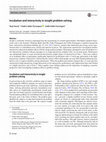
Psychological Research, 2018
Insight is commonly viewed as originating from the restructuring of a mental representation. Dist... more Insight is commonly viewed as originating from the restructuring of a mental representation. Distributed cognition frameworks such as the Systemic Thinking Model (SysTM, Vallée-Tourangeau and Vallée-Tourangeau, Cognition beyond the brain: interactivity and human thinking, pp 133-154, 2017), however, assumes that information processing can be transformed when it is distributed across mental and material resources. The experiments reported here investigated whether interactivity enhanced incubation effects with the cheap necklace problem. Participants attempted to solve the problem in a low-interactivity condition with pen and paper or in a high-interactivity condition with a set of metal chains. Performance was substantially better in a task environment that fostered a higher degree of interactivity at Time 1. There was evidence of an incubation effect as participants significantly improved in performance after a 2-week gap, particularly in the highinteractivity condition. Experiment 2 showed that the context within which people can enact their thinking following incubation is key to improve problem-solving performance. When the problem presentation changed after a 2-week gap (low interactivity to high interactivity or high interactivity to low interactivity), performance only improved for those who worked on a highly interactive task at Time 2. Taken together, these findings underscore the importance of adopting a systemic perspective when investigating incubation effects in problem solving.
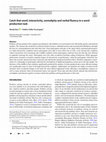
Psychological Research, 2020
Problem solving outside of the cognitive psychologist’s lab unfolds in an environment rich with b... more Problem solving outside of the cognitive psychologist’s lab unfolds in an environment rich with bodily gesture and material artefacts. We examine this meshwork of internal mental resources, embodied actions and environmental affordances through the lens of a word production task with letter tiles. Forty participants took part in the study which contrasted performance in a high interactivity condition (where participants were able to move letter tiles at will), a low interactivity condition (where movements were restrained) and a shuffle condition (where participants could not move the tiles but were allowed to randomly rearrange the array). Participants were also video recorded to facilitate coding of behaviour. While aggregate performance measures revealed a marginal impact of interactivity on performance, when the participants’ behaviour was taken into account, interactivity had a consistent and statistically significant beneficial effect. Detailed, exploratory examination of a su...

Acta Psychologica, 2016
Two experiments examined whether different task ecologies influenced insight problem solving. The... more Two experiments examined whether different task ecologies influenced insight problem solving. The 17 animals problem was employed, a pure insight problem. Its initial formulation encourages the application of a direct arithmetic solution, but its solution requires the spatial arrangement of sets involving some degree of overlap. Participants were randomly allocated to either a tablet condition where they could use a stylus and an electronic tablet to sketch a solution or a model building condition where participants were given material with which to build enclosures and figurines. In both experiments, participants were much more likely to develop a working solution in the model building condition. The difference in performance elicited by different task ecologies was unrelated to individual differences in working memory, actively open-minded thinking, or need for cognition (Experiment 1), although individual differences in creativity were correlated with problem solving success in Experiment 2. The discussion focuses on the implications of these findings for the prevailing metatheoretical commitment to methodological individualism that places the individual as the ontological locus of cognition.
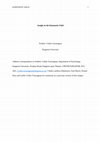
Insight problems offer an interesting tool to observe how new ideas are developed to solve simple... more Insight problems offer an interesting tool to observe how new ideas are developed to solve simple but vexing problems. Research typically proceeds with so-called second order procedures where participants are prevented from interacting with the world, forcing them to find a solution through mental processes alone. In contrast, when participants can interact with the environment they think with and through the world by building a physical model of the solution. Properly instrumentalized, such a first order procedure enables the granular tracing of the changes to the model of the solution. These changes reflect the co-constitutive coupling of thoughts and object, or object-thought mutualities. These mutualities are recovered with the mapping of the kinenoetic field, a term coined to capture the emergence of new ideas through the spatio-temporal changes to a physical object, namely the dynamic evolution of the model of the solution. We contrast the explanatory promises and challenges t...
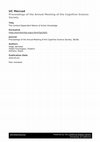
Recent theories of semantic memory have proposed that concepts are grounded in sensorimotor activ... more Recent theories of semantic memory have proposed that concepts are grounded in sensorimotor activity and mediated by the context from which the knowledge is drawn (Barsalou, 1999, 2003, 2008). Conceptual knowledge draws upon information from all modalities and therefore includes knowledge of associated object actions linked with both function and general movement (Bub, Masson, & Cree, 2008). The following experiment examined the conditions under which action information exerts an influence on experimental tasks particularly when taxonomic information is present. The experiment used a forced-choice triad task giving participants the choice of selecting between items that shared either a taxonomic or an action based relation with the target. The results showed that when the objects were presented as images on a white background (context-lean condition), participants were more likely to select the taxonomically related item. In contrast, when the same triads were presented as images be...
The effects of interactivity and ego depletion on planning were investigated using a sequential-t... more The effects of interactivity and ego depletion on planning were investigated using a sequential-task paradigm. Participants completed a 16-part trip-planning task in either a high-interactivity condition—where cards corresponding to events could be moved—or low-interactivity condition—during which moves were dictated to the experimenter and participants kept their hands down. Before that, half of the participants undertook an ego-depletion task. Planning performance was significantly better in the high than in the low-interactivity conditions; the main effect of ego depletion was never significant. These results suggest that interactivity augments working memory resources.

Our starting point in this chapter is the ecological tradition’s aspiration “to understand how or... more Our starting point in this chapter is the ecological tradition’s aspiration “to understand how organisms make their way in the world, not how a world is made inside of organisms” (Reed, 1996, p. 11). For an organism, “making one’s way in the world” is a continuous process: it is a behavioural and metabolic continuity where the organism-environment relation is regulated in a way that leaves traces in both the organism and the environment. The prerequisite for describing the organism-environment relation as being regulated is that the relation is sufficiently flexible: A living system’s flexible, adaptive behaviour is enabled by cognition. Accordingly, a cognitive trajectory intertwines with the organism’s behavioural and metabolic processes. We define this cognitive trajectory as an emergent pattern in a dynamic organism-environment relation, managed by the organism through continuous action-perception cycles. On this view, cognition does not play out in a separate, mediational (ment...
During a lab meeting, one of our PhD researchers recalls how her father would forbid her from usi... more During a lab meeting, one of our PhD researchers recalls how her father would forbid her from using paper to help solve maths homework problems by writing them down. Another admits that she sometimes still uses her hands to make small calculations, although she does so while hiding them behind her back. When we realise that all of us use our fingers in order to answer demands for the "third, fifth, and seventh digits" of our secret online banking password, we laugh in relief. We are not so daft after all, or at least we are not alone.
New Ideas in Psychology, 2020
We thank Wendy Ross for helpful discussions that helped us shape some of the arguments presented ... more We thank Wendy Ross for helpful discussions that helped us shape some of the arguments presented here, as well as two anonymous reviewers for their comments on a previous version of this manuscript.










Uploads
Papers by Frederic Vallee-Tourangeau